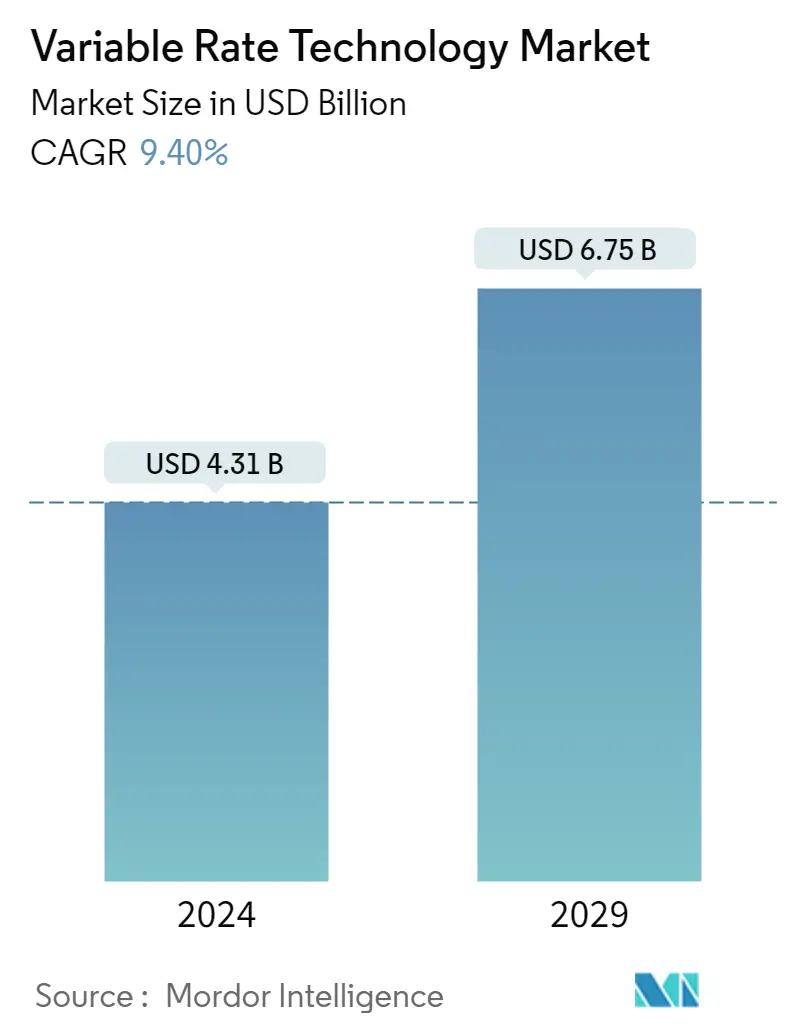Market Size of Variable Rate Technology Industry

| Study Period | 2019 - 2029 |
| Market Size (2024) | USD 4.31 Billion |
| Market Size (2029) | USD 6.75 Billion |
| CAGR (2024 - 2029) | 9.40 % |
| Fastest Growing Market | Asia Pacific |
| Largest Market | North America |
| Market Concentration | High |
Major Players*Disclaimer: Major Players sorted in no particular order |
Variable Rate Technology Market Analysis
The Variable Rate Technology Market size is estimated at USD 4.31 billion in 2024, and is expected to reach USD 6.75 billion by 2029, growing at a CAGR of 9.40% during the forecast period (2024-2029).
Referring to the current market dynamics of the industry, the adoption of variable rate technology is still very low even in the developed nations such as the United States. The ongoing studies by the agronomists across the world reveal that variable rate technology can have a positive impact on the crop yield, thereby aiding in the cost reduction, yield enhancement, and enhancement ofinput efficiency. Thus, the increasing awareness of the economic advantages of variable rate application adoption is likely driving the market during the forecast period.
Variable Rate Technology Industry Segmentation
Variable Rate Technology (VRT) is defined as any tool or system that allows varying the rate of crop inputs such as fertilizers, and crop protection chemicals based on the sensed or mapped crop characteristics. For the purpose of the study, the method of applications of VRT has been limited to the map-based and sensor-based.
| Crop Type | |
| Cereals & Grains | |
| Fruits & Vegetables | |
| Oilseeds & Pulses | |
| Commercial Crops |
| Application | |
| Fertilizers | |
| Crop Protection Chemicals | |
| Soil Sensing | |
| Yield Monitoring | |
| Irrigation | |
| Others |
| Geography | ||||||||
| ||||||||
| ||||||||
| ||||||||
| ||||||||
|
Variable Rate Technology Market Size Summary
The variable rate technology market is poised for significant growth, driven by the increasing awareness of its economic benefits in agriculture. Despite its low adoption rates in developed regions like the United States, ongoing research highlights its potential to enhance crop yields, reduce costs, and improve input efficiency. The integration of advanced technologies such as sensing systems, data analytics, and automated machinery is transforming precision farming, offering new opportunities for market expansion. The rising adoption of digital technologies in agriculture is expected to further propel the market, as these innovations enable more efficient and data-driven field operations.
The market landscape is characterized by a fragmented structure, with numerous small and medium-sized enterprises contributing to intense competition. North America and the Asia Pacific regions are particularly active, with a growing number of competitors. Although a significant portion of agricultural input dealers in the United States offer variable rate technology services, the actual acreage managed using this technology remains low due to the high costs associated with precise data collection. However, the increasing availability of these services is anticipated to drive market growth during the forecast period.
Variable Rate Technology Market Size - Table of Contents
-
1. MARKET DYNAMICS
-
1.1 Market Overview
-
1.2 Introduction to Market Drivers and Restraints
-
1.3 Market Drivers
-
1.4 Market Restraints
-
1.5 Industry Attractiveness - Porter's Five Force Analysis
-
1.5.1 Threat of New Entrants
-
1.5.2 Bargaining Power of Buyers/Consumers
-
1.5.3 Bargaining Power of Suppliers
-
1.5.4 Threat of Substitute Products
-
1.5.5 Intensity of Competitive Rivalry
-
-
-
2. MARKET SEGMENTATION
-
2.1 Crop Type
-
2.1.1 Cereals & Grains
-
2.1.2 Fruits & Vegetables
-
2.1.3 Oilseeds & Pulses
-
2.1.4 Commercial Crops
-
-
2.2 Application
-
2.2.1 Fertilizers
-
2.2.2 Crop Protection Chemicals
-
2.2.3 Soil Sensing
-
2.2.4 Yield Monitoring
-
2.2.5 Irrigation
-
2.2.6 Others
-
-
2.3 Geography
-
2.3.1 North America
-
2.3.1.1 United States
-
2.3.1.2 Canada
-
2.3.1.3 Mexico
-
2.3.1.4 Rest of North America
-
-
2.3.2 Europe
-
2.3.2.1 Germany
-
2.3.2.2 United Kingdom
-
2.3.2.3 France
-
2.3.2.4 Italy
-
2.3.2.5 Spain
-
2.3.2.6 Rest of Europe
-
-
2.3.3 Asia Pacific
-
2.3.3.1 China
-
2.3.3.2 Japan
-
2.3.3.3 India
-
2.3.3.4 South Korea
-
2.3.3.5 Rest of Asia-Pacific
-
-
2.3.4 South America
-
2.3.4.1 Brazil
-
2.3.4.2 Argentina
-
2.3.4.3 Rest of South America
-
-
2.3.5 Middle East and Africa
-
2.3.5.1 South Africa
-
2.3.5.2 Rest of Middle East and Africa
-
-
-
Variable Rate Technology Market Size FAQs
How big is the Variable Rate Technology Market?
The Variable Rate Technology Market size is expected to reach USD 4.31 billion in 2024 and grow at a CAGR of 9.40% to reach USD 6.75 billion by 2029.
What is the current Variable Rate Technology Market size?
In 2024, the Variable Rate Technology Market size is expected to reach USD 4.31 billion.

